By Linda Kekelis, Family Engagement Advisor and Ron Ottinger, Executive Director
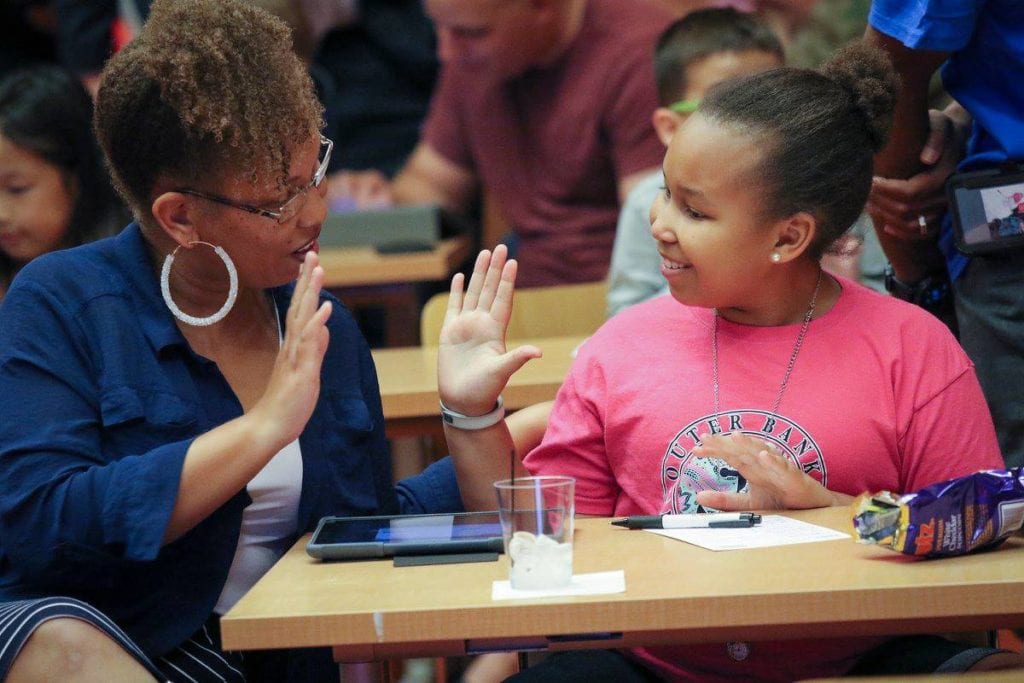
Photo Courtesy Family Code Night
Computer science, artificial intelligence, cybersecurity, and venture capital. Imagine youth in Detroit, DC, and Des Moines bringing their talents, fresh ideas, and social justice to these works. We get excited thinking about the possibilities. Like we do when we think about the numbers of kids who are expected to participate in this year’s Hour of Code and the number of students who took the AP Computer Science Principles exam in 2019. There are lots of bright spots in computer science both in and out of school. Kids and their families across the country and around the world are designing apps for social good with artificial intelligence — made possible by Technovation. With new badges in cybersecurity and coding, Girl Scouts is offering girls cutting-edge computer science and the opportunity to connect with role models who show the personal and professional rewards of careers in technology.
But all things aren’t created equal in computer science. The recent report on computer science on access and equity from Kapor Center shines a light on the serious inequities in participation in computer science. For us, this work hits close to home. There are endless possibilities and opportunities in computer science in our state with tech giants, startups, and venture capital. And yet, far too few students in California attend high schools which offer introductory and AP computer science courses. In fact, just 3% of the 1.9 million high school students in California were enrolled in computer science in the past three years. Especially troubling, are the prospects for low-income students, underrepresented students of color, female students, and rural students due to the large equity gaps in access and enrollment in computer science courses.
The statistics are sobering, and we want to change the status quo. STEM Next has been committed to quality STEM programming for all youth both as a funder and advocate for afterschool and summer learning. We are committed to taking on this opportunity gap in computer science by advocating for family engagement in order to promote engagement in programs both in and out of school.
As part of our commitment to closing this opportunity gap, STEM Next launched The Family Engagement Project to elevate the critical role of families in supporting youth, particularly youth who are under-represented in tech, to pursue and persist in computer science. Since our announcement at the CSforAll Summit in 2018 we have invested in a number of efforts to help advance greater equity in tech. We invite you to work with us to make sure that every child and every family has an equal opportunity to access and benefit from the possibilities that computer science has to offer. Here are five ideas to support families in your community.
#1 Expand computer science programs: Engage families too
STEM Next with the Larry and Helen Hoag Foundation is supporting Imagine Science of Orange County, California on its journey to deeper family engagement. Imagine Science of Orange County is a partnership across Boys & Girls Clubs of Garden Grove, Boys & Girls Clubs of Huntington Valley, Anaheim Family YMCA, 4-H of Orange County, and Girls Inc. of Orange County. This partnership is advancing each organization’s support for families of historically under-represented youth in science, technology, engineering, and mathematics (STEM). STEM Next is supporting these organizations for deeper family engagement beyond one-time showcase events at summer and afterschool programs. By understanding that family engagement doesn’t have to be just what’s done in programs, the Imagine Science team is expanding its support for families at home. We are supporting a community of practice that meets regularly to discuss research and practice on family engagement, to develop plans to listen to families and design with them, and to reflect on their work and learn together. In partnership and with a growth mindset, Imagine Science of Orange County is working to ensure that families are engaged during their afterschool programs and empowered for continued STEM engagement at home and in their communities afterwards.
For more ideas on computer science with families, look to Family Creative Learning, which is a free program of family coding events directed by Ricarose Roque with the Creative Communities research group at the University of Colorado Boulder. What we especially appreciate about Family Creative Learning is that it puts relationships at the center of its coding programs and designs with equity and access in mind. We also recommend Family Code Night, which offers resources to host an event for grades K-5 at elementary schools and youth organizations. The free event kit leads organizers through each step needed to plan and conduct a Family Code Night as well a Code On At Home flyer that has 40+ hours of games.
#2 Do more than computer science activities: Empower kids and parents to be their own brokers
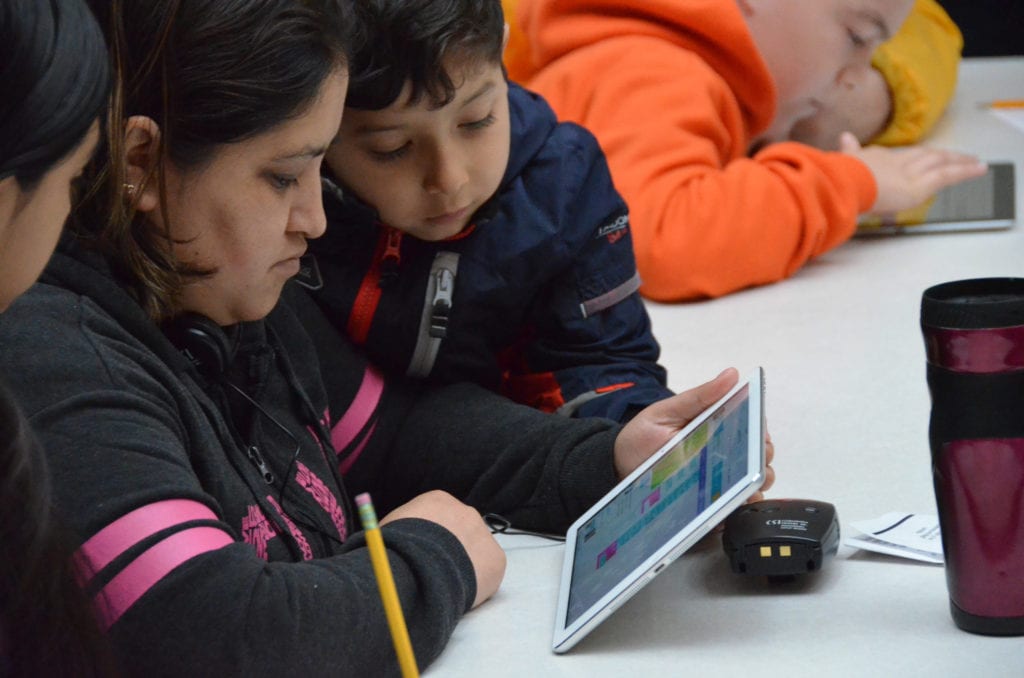
Photo Courtesy Family Code Night
Families bring different levels of knowledge and experience in computer science as well as social capital for accessing resources for their children. As you plan events and programs, we encourage you to flip the usual model of giving families resources; instead set up opportunities where families — kids and their parents — learn from one another how and where to access computer science programs.
You can learn different ways to elevate families’ role in this work from Family Creative Learning, Digital Youth Divas, and Greene Scholars programs. In these programs, parents learn from one another within casual conversations during meals, structured discussions, and debriefs at the end of programs. We especially like how Digital Youth Divas supports families in a way that recognizes and leverages existing networks, histories, cultures, and expertise in their communities and shares resources to help other organizations in this work. For example, in one activity they share research about brokering and invite families to think about how to be brokers for their child. In another activity, parents think about their child’s interests and develop a plan to connect their child to new learning opportunities that are available in their community and online.
#3 CSforAll: Be intentional and invite youth with disabilities to your tech programs
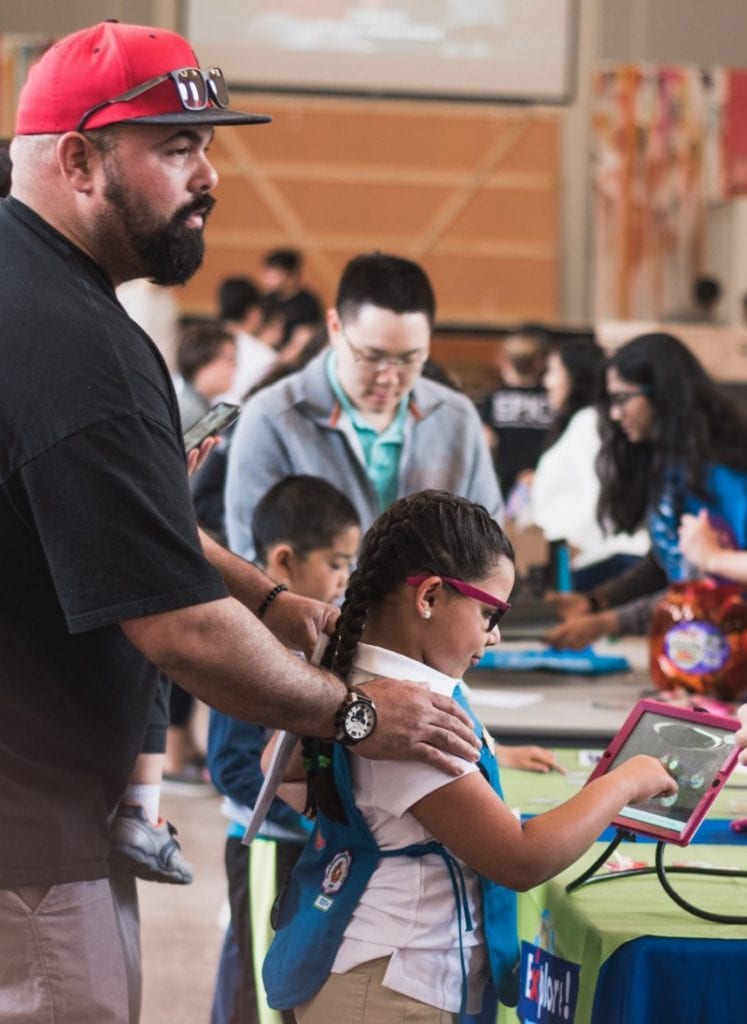
Photo Courtesy Deaf Kids Code
What does “for all” mean? If we consider the percentages of kids with disabilities participating in afterschool programs as an indicator, we have a long way to go to become inclusive. Don’t leave it up to families to advocate for computer science programs for their kids or to request accommodations for their child’s disability. Kids Included Together (KIT) and the National AfterSchool Association have launched a partnership to make afterschool programs a welcoming and safe place for children and youth with disabilities. The summer 2019 issue of Afterschool Today shows bright spots in this work. We especially like these ideas — creating advisory boards that include families being served, inviting families to give input on program materials and activities, asking for help to understand barriers and design solutions, and inviting parents and kids to visit programs so that they feel welcomed.
You can find positive examples of what’s possible for youth with disabilities with Deaf Kids Code, Youth Code Jam, and Tech Kids Unlimited. Each of these programs defies the statistics and shatters stereotypes to create diverse and inclusive tech programs. Look to their leadership for inspiration and guidance in welcoming families and helping them see the possibilities for their children in computer science.
#4 Girls and computer science: Encouragement matters
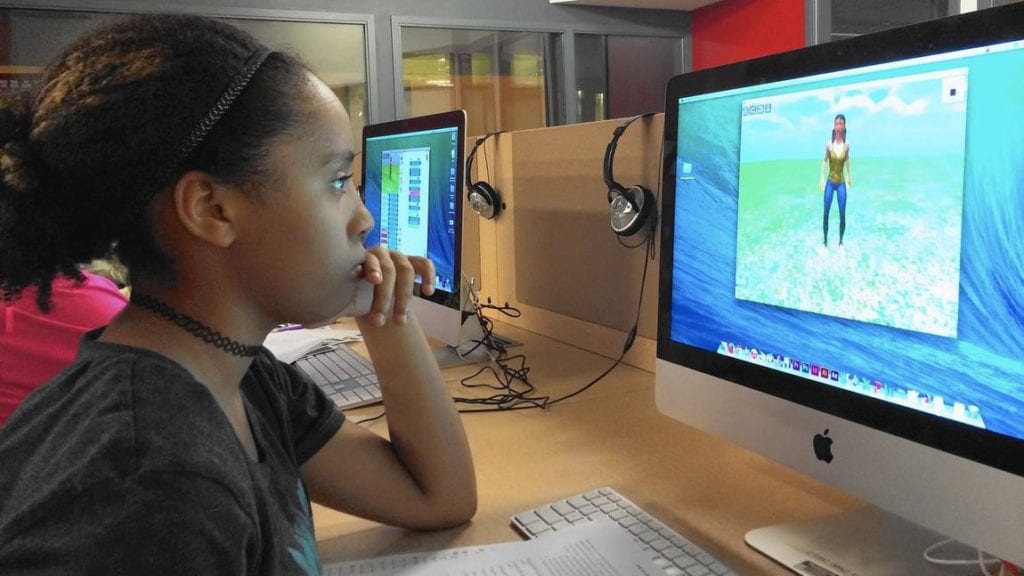
Photo Courtesy Digital Youth Divas
Parents want the best for their daughters. Yet they may hold back their daughters unintentionally because of assumptions and stereotypes. In a study of parent support on the development of media skills, researchers found that boys’ interest in tech was recognized earlier than girls. Also, parents provided resources to support sons’ tech interest at an earlier age and offered more guidance when the projects were complicated. Are boys really interested in computers sooner than girls? We think it’s more likely that unconscious gender bias is at play. Encourage parents to recognize and support their daughters’ interest and confidence in technology. Confidence can play a significant role in girls’ willingness to try and persist in computer science. We recommend programs like Black Girls Code and Girls Who Code that empower girls through coding.
While parents may think that it’s their expertise, experience, or knowledge that makes for their child’s success in computer science, research shows otherwise. In a longitudinal study spanning high school through college and into the start of a career, the National Center for Women & Information Technology (NCWIT) identified which variables in girls’ computing experiences best predicted their persistence in computer science and technology-related majors three years later. Giving girls access to computer programming courses in high school supported by strong parental and teacher engagement arose as important factors in ensuring girls will persist over obstacles to continue studying computer science in college and entering a tech career. Encouragement by parents comes in many forms like asking questions, inviting their daughter to show them what they’re learning, and enrolling them in computing programs.
#5 Competitions and challenges: Are we advancing equity and access?
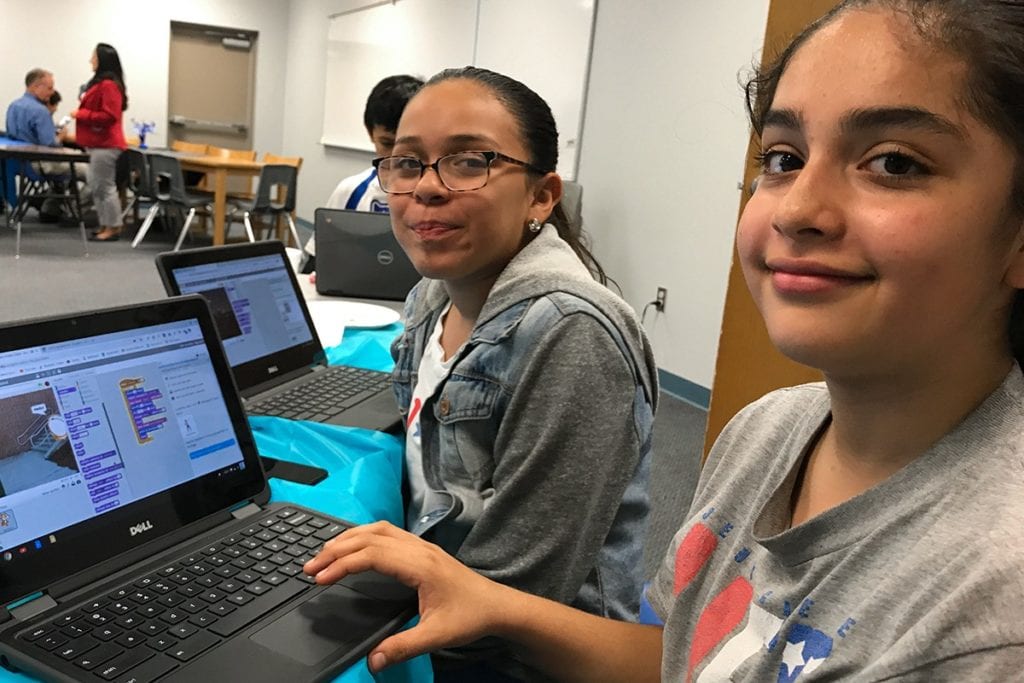
Photo Courtesy Tecnovation
Lots of computer science opportunities are presented as competitions and challenges. FIRST Robotics, Lemelson-MIT InvenTeams, NCWIT Aspirations in Computing, and Technovation offer opportunities to compete with other youth in technology for prizes and recognition. While these programs offer positive benefits for many, we caution that they can also increase the digital divide. Ask yourself, Who thinks they’re not smart enough to apply? Who doesn’t have access to mentors to help them plan and execute successful projects? Who is overcome by challenges and failures that are part of tech challenges? These questions might help you identify ways to prevent unintentionally increasing the digital divide.
For those who host challenges we advise consideration of who might be privileged by their social capital and who might be disadvantaged by their life’s opportunities. The following promising practices from Juliet Ollard provide some helpful considerations. Start by designing competitions with those who are most excluded in mind, to make for more inclusive opportunities. Offer topics and themes that relate to youths’ experiences and interests rather than the host’s personal interests. Support teams with mixed assets and abilities from start to finish. Don’t create more one-off experiences; instead build in sustained support for long-term outcomes. Build in opportunities and support for iterating and reflecting on successes and challenges.
We hope that one or more of the ideas in this blog help you engage families in your computer science efforts. For more strategies on supporting families in computer science, visit the Family Engagement Project at STEM Next. You will find our white paper and other resources to empower families in STEM. We are committed to ensuring that every family has access to the opportunities to support their child at home and to broker opportunities in their communities. Together we can reimagine the possibilities and collectively advance CSforALL’s mission to make high-quality computer science a part of the educational experience of all K-12 students and support their pathways to college and career success.
We give a shout out to the leadership of CSforALL for its policy work at the local, state, and national levels, school and district innovation, teaching, and research. We also appreciate Infosys Foundation USA for its support of several of the programs mentioned in this blog — Deaf Kids Code, Family Code Night, Tech Kids Unlimited, and Technovation. CSforAll grants to these organizations were made in celebration of #CSEdweek 2018. We look forward to this year’s grants and the work that they support.
Linda Kekelis, PhD, is an advisor for STEM Next Opportunity and founder and former CEO of Techbridge Girls. Family engagement has been a passion for Linda and at the center of the research and programs she has led. lkekelis@gmail.com @LindaKekelis
Ron Ottinger is Executive Director of STEM Next Opportunity Fund and former co-chair of the national STEM Funders Network and the National STEM Learning Ecosystem Initiative. @stemnext.org

